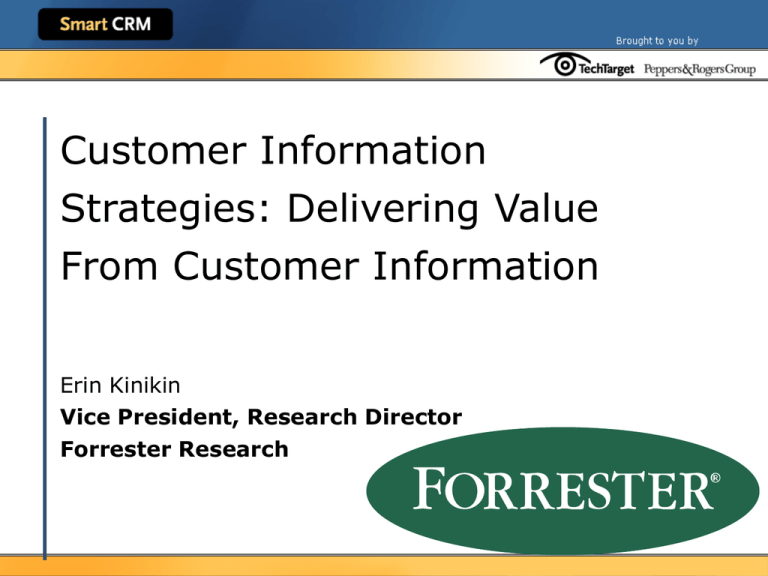
Customer Information
Strategies: Delivering Value
From Customer Information
Erin Kinikin
Vice President, Research Director
Forrester Research
Spending on Customer Information is
Increasing
Source: The State Of Technology Adoption, May 2004, Forrester Research
But results aren’t always in line
with spending
“All our customer data is in silos by
product line — we can’t recognize
customers across products”
“It’s not just providing the information —
it’s teaching people how to use it”
“By the time we get back to a customer at
risk -- they’ve already left.”
“Star schema? No, we don’t have a
snowflake schema either, we have a
blizzard!”
Different Industries Target Different Goals
Goal
Industry
Information
Revenue,
sales
effectiveness
High tech,
pharmaceutical
Purchase trends,
product mix, growth
Profitability,
retention
Banking, retail,
communications
Net new customers,
product mix, interaction
history
Compliance
Financial
services,
insurance,
high tech
Service levels,
contracts,
identity validation,
privacy preferences
Risk mitigation
Insurance
Product portfolio,
risk exposure
Lower IT costs
All
Cost of integration,
CRM adoption rates
Building a Customer Information
Strategy is Like Building a House
From Data to Business Value
Strong governance model
Clear strategy and ROI
Comprehensive information practices
Continuous measurement
Governance: Build the Right Team
Executive steering
committee (ESC)
Customer information
strategy group
Cross-functional
program team
Project
teams
Data
stewards
Prioritizes initiatives
Approves funding
Resolves conflicts as required
Empowered by the ESC
Defines how information can be
used to drive value
Recommends and justifies
The critical bridge between
business and IT
Executes the action plan
Within the LOB or IT
Manages a discrete project
Monitors post-execution
performance
Example: Insurance Company
Executive steering
committee (ESC)
Customer
information
strategy group
Cross-functional
program team
Project
teams
Data
stewards
Move from product to customer
centricity
Central funding — $25 million
over five years
New function establishes
enterprise processes
Uses pilots to demonstrate value
Central compliance and privacy
management
Consistent processes across LOBs
Single application process
standardizes customer inputs
Security model protects
proprietary information
What it Means to You
Pick a business
sponsor with a vision
for change
Use information and
pilots to prove the
vision
Plan for
organizational and
process change
Information Must Support Customer Strategy
CRM value plan
Business
goals
Why?
Strategies
What?
Tactics
How?
Information
Corporate
business
objectives
Measure business
performance
Market share, retention
rates, profitability,
segment ownership
Customer-focused
approaches in
support of
business goals
Analyze, segment and
target
Value, propensity, risk,
products, trends
Specific business
actions required to
implement each
strategy
Initiate action (e.g.,
trigger events)
Incentives and outcomes
Customer Example: Retail Bank
CRM value plan
Information
Increase
retention and
value
Customer retention
Share of wallet
Usage of online channels
Promote product
mix to drive
loyalty
New customer
program,
retention alerts
Optimal product mix by
customer type
Customer preferences
Behavioral detail
Trigger events: new customer
or account, address change,
change in usage pattern
What it Means to you
Start with a
business goal
Define how
information can
support the strategy
Develop use-case
scenarios to make
the strategy real
Establish Information Processes That
Support the Strategic Plan
Establish a
source of
record
Standardize,
consolidate,
and enhance
Maintain
Assess the state of the data
Define business rules
Address data quality at entry
Define exception handling
Breadth of data
Cross-reference keys
Build aggregates
Define update frequency
Establish clear owners
Define maintenance rules
Build ongoing validation and
alerting processes
Customer Example: Retail Banking
Goal
Data sources
Increase customer
penetration
Solution
Staging area
Highly parallel,
custom wrappers
around Trillium
and Abinitio
Contact center
and branch
desktop
Householding
engine
Xref
Marketing
automation
Customer data from all
major lines of business
Weekly match/merge and
householding process —
285 million records per
week
Linkage between analytic
and operational systems
Benefits
Better alignment of
products to customer needs
More timely customer
response
Customer Example: Pharmaceutical
12 data sources
Goal
Faster insight to
prescription patterns
More comprehensive and
accurate data
Solution
Siperian
customer hub
Customer hub automates
consolidation
Change requests via SFA
Results
Siebel
Customer
data
warehouse
Marketing
system
Reduced load times from
one month to one week
Add new data sources in
days, not months
Setting Policies and Practices — Data
Stewards
Establishes policies and
Central quality
group
Ongoing
cleansing
Regional business operations
best practices
Maintains a policy Web site
Monitors compliance
Arbitrates disputes
Identifies company of
record
Addresses match/merge
issues
Monitors quality over time
Rapid response to sales
requests
Local quality monitoring
Customer Example: High Tech
Leads
Unverified
Goal
Hot opportunities,
Web orders
Pending
validation
Solution
Validated
customers
Active
Inactive contacts
or accounts
Streamline order processing
Sales efficiency
Single customer master
Tiered stewardship model
Results
Inactive
Reduced cleansing costs
by 40%
Reduced sales order time
What it Means to you
Stop bad data at the
point of entry, if
possible
Build the people
processes to
maintain
the data
Understand data
timeliness
requirements
Measurement: Measuring the Right Things
CRM value plan
Business goals
Why?
Type of metrics
Performance
Strategies
What?
Diagnostic
Tactics
How?
Interaction
Customer Example: Retail Bank
CRM value plan
Increase
retention and
value
Promote product
mix to drive
loyalty
New customer
programs,
retention alerts
Type of metrics
Performance
Market share,
retention, customer
profitability
Diagnostic
Products per customer
Interaction
Response rates, activations,
usage metrics
What it Means to You
Match the metrics to
the goals
Use diagnostic and
interaction metrics to
monitor and tune
Make sure incentives are
in line with customer
objectives
Recommendations
To avoid this…
Remember that the
customer view is only the
foundation
Make sure leadership owns
the vision and the right
team is in place to deliver
Define a clear strategy and
specific business tactics to
drive usage and value
Put the proper
measurements in place
Thank You
Erin Kinikin
+1 408/327-4321
ekinikin@forrester.com
www.forrester.com
Entire contents © 2004 Forrester Research, Inc. All rights reserved.
What is the current state of your
customer information?
1. Inconsistent
2. Mostly consistent within a function or line of
business
3. Consistent across functions and lines of business
4. Only consistent in the data warehouse
What is the biggest barrier to leveraging
customer information?
1. Lack of executive commitment
2. Project and technology expense
3. Inconsistent processes and policies
4. Barriers to sharing information
5. Unclear business value
6. Other business priorities
7. Other IT priorities
What is the single greatest driver at your
company for better customer information?
1. Cross sell / up sell
2. Customer retention / tiered service
3. Cost savings
4. Improved compliance (privacy, Patriot Act, etc.)
5. More timely response to customer change
6. Better coordination across business units or
geographies
7. Other






